Birding
The north Norfolk coast has an enviable reputation as one of the major birding hotspots in the U.K. and the village of Holme-next-the-Sea is very well placed to act as a base for any keen birder. All along the coast there are many valuable habitats including extensive areas of sand and shingle beaches, saltmarsh, reedbed and fresh, brackish and saline lagoons. The Wash, which is the biggest estuary in the UK, is internationally important for large numbers of wintering birds because of its vast expanses of inter-tidal mudflats for feeding and safe roost sites.
This is the famous male Collared Flycatcher which pleased the many birders who flocked to Holme-next-the-Sea on the 8th May, 2011.
Picture by kind permission of the photographer, Lynne Demaine.
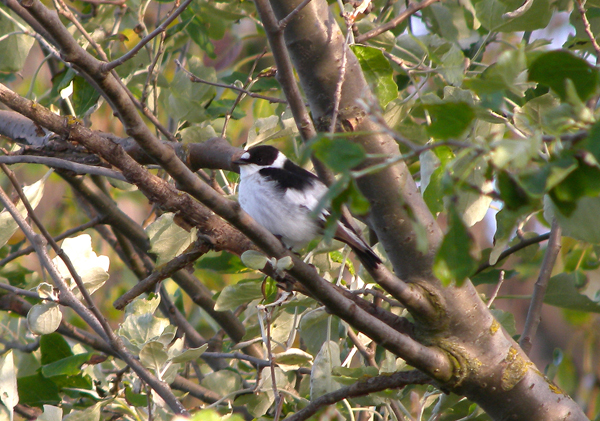
The picture below shows the well publicised twitch for the White-crowned Sparrow at Cley-next-the-Sea in January, 2008!

The major attraction for bird watchers is the fact that the excitement never really stops. Bird watching here has peaks in spring and autumn when there is an excellent
variety of warblers and other migrants to be seen and during these main migration periods almost anything can, and does, turn up! However, outside of these busy times there
is still much to be seen and any of the local reserves will always provide a good day's birding.
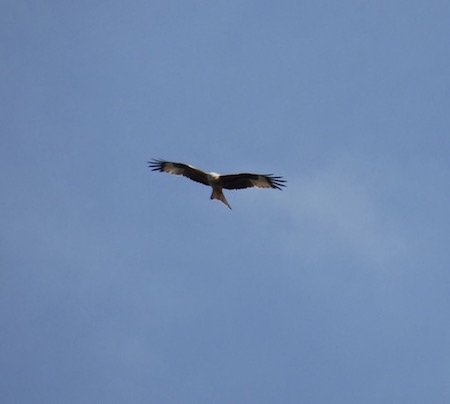
A Red Kite floating over the centre of Holme-next-the-Sea mid-April, 2015 - possibly a migrating Continental bird.
There were at least two Red-flanked Bluetail seen well during the second and third weeks of October 2020. Story on the Gallery page.
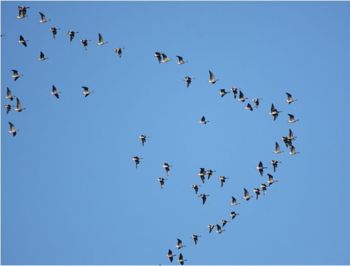
The big bonus on offer here is during the winter months. This part of Norfolk is home to thousands of visiting geese. Huge numbers of Brent Geese
and even more Pink Footed Geese bring a special kind of beauty to the marshes and fields around Holme-next-the-Sea. Surely there cannot be a more breathaking site than
a very big sky filled, yes filled, with huge skeins of geese returning to their roost at the end of The Wash as the sun is going down.

Here we see two views of Pink Footed Geese against different coloured skies.
Even the resident birds, which the locals almost take for granted, can make any birder's day. Barn Owns are easy to see here and the Marsh Harrier is one
of our more common raptors. Factor in practically guaranteed sites for Corn Bunting, Kingfisher and Avocet and top up with the chance of Bittern and the magic
just doesn't stop. Even a few Fulmars can usually be seen from the cliff-top or beach at Hunstanton.
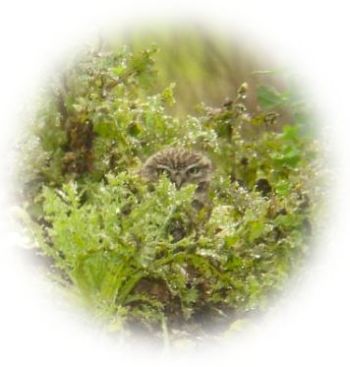
Every birder naturally wants to be spoilt with good sites and reserves. Well, here in Norfolk we have some of the best in the U.K.
The RSPB manages the famous
Titchwell Marsh reserve. Although Sammy, the Black Winged Stilt, is no longer present the reserve always manages to satisfy. The birds are easy to
see and there is often an 'expert' nearby to give an opinion about what you are looking at! The visitor centre here is brilliant and The Feeding Station
enjoys a well deserved reputation for serving good food.
 Closer to home at Holme-next-the-Sea the Norfolk Ornithologists' Association has an excellent small
reserve and observatory looking over Broadwater, a large expanse of water close to the coast. There are hides, including a sea-watching hide, and a dedicated ringing
station. Day permits are available to non-members. This splendid juvenile Red-necked Phalarope posed for several days in front of the NOA members' hide on Redwell
Marsh in September, 2010.
Closer to home at Holme-next-the-Sea the Norfolk Ornithologists' Association has an excellent small
reserve and observatory looking over Broadwater, a large expanse of water close to the coast. There are hides, including a sea-watching hide, and a dedicated ringing
station. Day permits are available to non-members. This splendid juvenile Red-necked Phalarope posed for several days in front of the NOA members' hide on Redwell
Marsh in September, 2010.
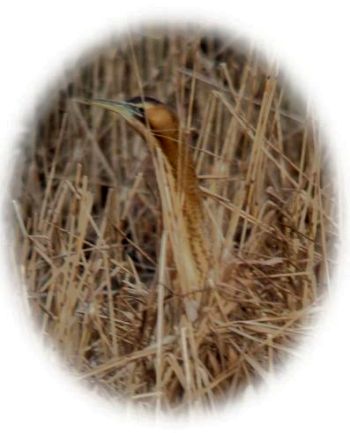
 The Norfolk Wildlife Trust manages the Holme Dunes Reserve which
is adjacent to the NOA's reserve and also overlooks Broadwater. There are more hides here and an interesting woodland area of Corsican Pines. The NWT also issue day
permits to non-members.
The Norfolk Wildlife Trust manages the Holme Dunes Reserve which
is adjacent to the NOA's reserve and also overlooks Broadwater. There are more hides here and an interesting woodland area of Corsican Pines. The NWT also issue day
permits to non-members.
Further eastwards along the coast the Norfolk Wildlife Trust offers the famous Cley Marshes reserve at Cley-next-the-Sea. The NWT have built a brand new, environmentally friendly visitor centre where you will find an observation
area within the cafe so that you can enjoy a coffee and a bun whilst birding! This is another reserve with a fantastic reputation for turning up rarities and even on a
dull day you won't be disappointed.
Scolt Head Island NNR is a National Trust
site managed by Naural England. Access is via a ferry from Burnham Overy Staithe which only runs during the summer months.
The RSPB have another well known reserve at Snettisham. Located at the
back end of The Wash this is the place to be about an hour before really high tides. As the water rises to cover the hugh area of mudflats tens of thousands of waders are
pushed off their feeding grounds to seek a roost on the banks and islands in front of the RSPB hide. The enormous flocks of Knot in particular offer the visitor a chance to see
one of the most amazing birding shows as they wheel and turn in formation flashing silver. There is always the chance of a Peregrine Falcon here - they rather fancy their
chances of a hit with so many targets to choose from!
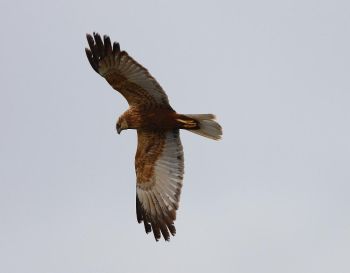
There are smaller, but still very interesting, birding sites all the way along the coast. Salthouse, Kelling, Friary Hills, The Burnhams and Holkham Pines at the Holkham National
Nature Reserve are just a few of the numerous locations which all have something to offer the exploring birder.
Other sites with a reputation for delivering the goods include Chosely Drying Barns,
Abbey Farm at Flitcham and the woods and lake at Holkham Hall.
 For something different take one of the regular boat trips from Morston out to the
Blakeney National Nature Reserve and see the Tern colonies. During the summer you will see mostly Common, Sandwich and Little Terns but there are often Arctic
Terns present. To make your day you will also see the breeding colonies of Common and Grey seals - and really close up so don't forget your camera!
For something different take one of the regular boat trips from Morston out to the
Blakeney National Nature Reserve and see the Tern colonies. During the summer you will see mostly Common, Sandwich and Little Terns but there are often Arctic
Terns present. To make your day you will also see the breeding colonies of Common and Grey seals - and really close up so don't forget your camera!

Penny Clarke, who lives locally, frequently uploads bird news on her super blog at Penny's Hot Birding and Life!
Lots of good stuff here and it's always up to date - visit the blog to find out what's about.
...and for that really different bird that you cannot readily identify perhaps you should try the
RSPB's Bird Identifier.
If you are birding with children in tow you might like to consider a fantastic new game that has been put together in order to support kids in learning about their local wildlife
and to also enable them to share what they discover with other children around the country. Check it out at
Fly On The Wall - Wildlife Trackers.
